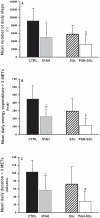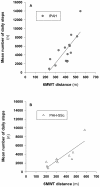Assessment of daily life physical activities in pulmonary arterial hypertension
- PMID: 22110770
- PMCID: PMC3218075
- DOI: 10.1371/journal.pone.0027993
Assessment of daily life physical activities in pulmonary arterial hypertension
Abstract
Background: In pulmonary arterial hypertension (PAH), the six-minute walk test (6MWT) is believed to be representative of patient's daily life physical activities (DL(PA)). Whether DL(PA) are decreased in PAH and whether the 6MWT is representative of patient's DL(PA) remain unknown.
Methods: 15 patients with idiopathic PAH (IPAH) and 10 patients with PAH associated with limited systemic sclerosis (PAH-SSc) were matched with 15 healthy control subjects and 10 patients with limited systemic sclerosis without PAH. Each subject completed a 6MWT. The mean number of daily steps and the mean energy expenditure and duration of physical activities >3 METs were assessed with a physical activity monitor for seven consecutive days and used as markers of DL(PA).
Results: The mean number of daily steps and the mean daily energy expenditure and duration of physical activities >3 METs were all reduced in PAH patients compared to their controls (all p<0.05). The mean number of daily steps correlated with the 6MWT distance for both IPAH and PAH-SSc patients (r = 0.76, p<0.01 and r = 0.85, p<0.01), respectively.
Conclusion: DL(PA) are decreased in PAH and correlate with the 6MWT distance. Functional exercise capacity may thus be a useful surrogate of DL(PA) in PAH.
Conflict of interest statement
Figures



Similar articles
-
Physical activity limitation as measured by accelerometry in pulmonary arterial hypertension.Chest. 2012 Dec;142(6):1391-1398. doi: 10.1378/chest.12-0150. Chest. 2012. PMID: 22576635 Free PMC article.
-
Nailfold capillaroscopic changes in patients with idiopathic pulmonary arterial hypertension and systemic sclerosis-related pulmonary arterial hypertension.Microvasc Res. 2017 Nov;114:46-51. doi: 10.1016/j.mvr.2017.06.005. Epub 2017 Jun 12. Microvasc Res. 2017. PMID: 28619664
-
Right Ventricular Myofilament Functional Differences in Humans With Systemic Sclerosis-Associated Versus Idiopathic Pulmonary Arterial Hypertension.Circulation. 2018 May 29;137(22):2360-2370. doi: 10.1161/CIRCULATIONAHA.117.033147. Epub 2018 Jan 19. Circulation. 2018. PMID: 29352073 Free PMC article.
-
Systemic sclerosis-associated pulmonary arterial hypertension.Chest. 2013 Oct;144(4):1346-1356. doi: 10.1378/chest.12-2396. Chest. 2013. PMID: 24081346 Free PMC article. Review.
-
[Evaluation of exercise capacity in pulmonary arterial hypertension].Turk Kardiyol Dern Ars. 2010 Dec;38(8):580-8. Turk Kardiyol Dern Ars. 2010. PMID: 21248462 Review. Turkish.
Cited by
-
Continuous reduction in cerebral oxygenation during endurance exercise in patients with pulmonary arterial hypertension.Physiol Rep. 2020 Mar;8(6):e14389. doi: 10.14814/phy2.14389. Physiol Rep. 2020. PMID: 32189447 Free PMC article.
-
Implantable system for treprostinil: a real-world patient experience study.Pulm Circ. 2020 Apr 22;10(2):2045894020907881. doi: 10.1177/2045894020907881. eCollection 2020 Apr-Jun. Pulm Circ. 2020. PMID: 32363029 Free PMC article.
-
Actigraphy methodology in the Kids Mod PAH trial: Physical activity as a functional endpoint in pediatric clinical trials.Pulm Circ. 2024 Mar 8;14(1):e12339. doi: 10.1002/pul2.12339. eCollection 2024 Jan. Pulm Circ. 2024. PMID: 38464344 Free PMC article.
-
Skeletal and respiratory muscle blood flow redistribution during submaximal exercise in pulmonary hypertensive rats.J Physiol. 2025 Jan;603(2):337-351. doi: 10.1113/JP287549. Epub 2024 Dec 3. J Physiol. 2025. PMID: 39625445
-
Relationships that perceived barriers to physical activity have with functional capacity and quality of life in patients with pulmonary hypertension.J Bras Pneumol. 2025 Mar 31;51(1):e20240195. doi: 10.36416/1806-3756/e20240195. eCollection 2025. J Bras Pneumol. 2025. PMID: 40172409 Free PMC article.
References
-
- Groepenhoff H, Vonk-Noordegraaf A, Boonstra A, Spreeuwenberg MD, Postmus PE, et al. Exercise testing to estimate survival in pulmonary hypertension. Med Sci Sports Exerc. 2008;40:1725–1732. - PubMed
-
- Miyamoto S, Nagaya N, Satoh T, Kyotani S, Sakamaki F, et al. Clinical correlates and prognostic significance of six-minute walk test in patients with primary pulmonary hypertension. Comparison with cardiopulmonary exercise testing. AmJRespirCrit Care Med. 2000;161:487–492. - PubMed
-
- Provencher S. Long-term treprostinil in pulmonary arterial hypertension: Is the glass half full or half empty? EurRespir J. 2006;28:1073–1075. - PubMed
-
- Sitbon O, Humbert M, Nunes H, Parent F, Garcia G, et al. Long-term intravenous epoprostenol infusion in primary pulmonary hypertension: prognostic factors and survival. JAmCollCardiol. 2002;40:780–788. - PubMed
Publication types
MeSH terms
LinkOut - more resources
Full Text Sources
Medical

